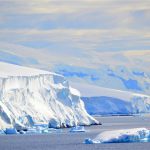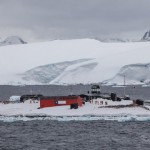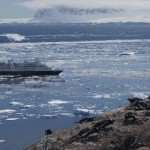
Sunday, December 22, 2013 — This morning, to mark the end of my Antarctic cruise on Silver Explorer, I boarded a charter flight in Ushuaia, bound for Buenos Aires. It is remarkable to think that in the span of a few days, I will have traveled from seas of ice and landscapes of snow-draped mountains, from rocky perches populated with wobbly penguins and snowy fields of sedate seals, from the world’s coldest, windiest and driest place — from a remote continent across the dreaded Drake Passage to the town at “end of the world,” where I boarded an Airbus 320 to conclude a wonderful trip in bustling Buenos Aires.
Here, in this vibrant capital city, temperatures (and tempos) are throbbing. Far from feeling the grandeur of Antarctica, I am in a hot and busy metropolis — as intense as the tango that originated near this city more than a century ago. Wildlife and nature are not spectacles here, as they were on the White Continent.
While the contrasts between Buenos Aires and Antarctica could not be greater, this short break in Buenos Aires, this pause between a life-enriching journey and my return home, provides the perfect platform to reflect on what will go down as one of the most rewarding travel experiences of my life.
There are at least four reasons that my Silver Explorer voyage to Antarctica was so memorable to me. These are perhaps reasons for you to consider planning your own voyage to the last continent on earth to be discovered and charted.
1. Seven Continents Done: Check That Off The List

My two feet have now padded ground on all seven continents. For many of the 114 guests aboard Silver Explorer, securing a foothold on the seventh continent was a worthy achievement in and of itself. One couple on our voyage even went so far as to renew their wedding vows in Antarctica.

Clearly, we were part of an exclusive group of travelers: Only 40,000 people visit Antarctica annually, according to statistics from the International Association of Antarctic Tour Operators (IAATO). And only a little more than half of those visitors actually set foot on the continent.
While Antarctica awes even travelers who do not stand atop its frozen ground (vessels carrying more than 500 passengers are not allowed to execute landings to bring their guests ashore), to actually plant two feet on Antarctica is quite something else.

There are two things that make going ashore possible.
- Small ships. IAATO guidelines stipulate that no more than 100 visitors shall be ashore at any one time in any one place in Antarctica. With only 132 guests (and only 114 on our voyage, which was full, but some suites were occupied by solo travelers), Silver Explorer was able to rotate all guests ashore efficiently so that at least two landings could be executed each day.
- Zodiacs. The flat-bottom, virtually indestructible, inflatable boats could land us on beaches and take us on tours in places that even our small ship was too large to reach. Zodiacs were essential to the Antarctic experience. “Without them, we could only do a scenic cruise and go back to Ushuaia without ever landing,” Silver Explorer Expedition Leader Kara Weller told us during our first full day of the voyage.
My advice: If you plan on visiting Antarctica, pack your boots (or rent them as I did) and get yourself ashore. Just make sure you’re on a ship, such as Silver Explorer, than can deliver that experience.
2. Up-Close Encounters With Penguins & Other Wildlife
Only by stepping ashore can one experience up close encounters with penguins, seals and other wildlife (abiding the 5-meter rule, of course, which stipulates maintaining a distance of about 15 feet from wildlife). With such easy access to the animals and their lack of fear of humans, my traveling companion — Vancouver-based videographer Chris Stanley — and I were able to snap photographs that we will enjoy showing our friends and family for years to come.
During the regular “Recap & Briefing,” a daily presentation about all that we had seen during the day and what we would experience the next day, one of the expedition team members told us that no one was indifferent to penguins.

Indeed, the penguins were both mesmerizing and amusing. We could (and did on some days) spend hours observing them. In my post Penguinology 101: Preparing For A Voyage To Antarctica, I wrote that I hoped to see King and Emperor penguins. To see those species, however, you will need to do the longer cruise itineraries, which include South Georgia and the South Sandwich Islands, another trip now on my bucket list.

On the Antarctic Peninsula, we saw mostly gentoo, chinstrap and Adelie penguins — waddling about, protecting their nests, collecting pebbles (to build nests), stealing pebbles from other penguins (also to build nests), crapping — all modes of penguin life. Click here to read about my first penguin encounters.
In addition to penguins, we saw many seals, mainly the elephant and Weddell species. We discovered that the most fun way to observe and photograph the seals was on our bellies in the snow, with cameras poised.




The up-close encounters with wildlife will be reason enough for some to visit Antarctica.
3. Antarctica Has Endless Allure
Antarctica is a place where superlatives are easily exhausted. It is exuberantly awesome. During our twice-daily landings, we walked on glaciers and hiked up snowy bluffs, activities that rewarded our group of modern-day explorers with the most beautiful views that you can imagine.
When sailing, we looked out on mountains covered in snow and seas of chunky ice. Often, we stood out on deck (or on our verandas) as Silver Explorer, a ship built for polar exploration, navigated sublime ice-choked channels. The beauty of Antarctica was simply breath-taking.

I had seen documentaries about Antarctica. I had read articles accompanied by beautiful photography, but nothing came close to actually experiencing Antarctica. It is so vast, and a place of such extremes, that it deems descriptions insufficient.
Antarctica’s vastness and its pristine condition can be overwhelming. Here, nature rules; humans are small and insignificant. Penguins pay scant attention to visitors, and seals seldom bother to look up at those admiring them. To visit Antarctica is a humbling experience.

A few factual superlatives: Antarctica is the world’s coldest, driest and windiest place. It is the earth’s largest dessert, its largest wilderness area. It is a land of extremes. Earth’s coldest temperatures were recorded here in August 2010: -94.7C (-135.8F). In July of this year, the mercury plunged to -92.9C (-135.3F).
Figures like those may have you asking whether Antarctica is too cold for a cruise. Nope. Temperatures on the Antarctic Peninsula, which is where we spent most of our time, averaged around the freezing mark during the Austral summer. One day was so warm that I removed my parka.
In fact, we were traveling at about the same latitude (but on the bottom side of the world) as Stockholm, Sweden. We never crossed the Antarctic Circle, which was quite a distance farther south — and presumably blocked by ice.

For those who want to experience one of the world’s most pristine places, Antarctica will not disappoint.
4. Camaraderie Among Cruisers/Explorers
On nearly all of my cruises, I’ve met wonderful people, but I’ve yet to be part of a group that bonded as well as ours on Silver Explorer. Perhaps it was the powerful shared experiences of the collective that created such a strong spirit of camaraderie among the 114 guests. If only the rest of the world could get along as well as we did on that voyage.
And we were far from homogenous. In a previous post, I mentioned the diverse international mix of nationalities. To recap, we were:
- 9 Australians
- 1 Austrian
- 1 Canadian
- 18 Chinese
- 5 from Hong Kong
- 2 Japanese
- 1 Latvian
- 1 Malaysian
- 2 Dutch
- 1 Russian
- 10 Singaporeans
- 4 Swiss
- 10 Taiwanese
- 13 from the United Kingdom
- and 36 from the United States
Our days were active and edifying. We learned quite a bit ashore and supplemented our new-found knowledge back on the ship at the “Recap & Briefing” as well as at presentations such as the following that took place during our time on board:
- “Demon Fish — The Ultimate Predator” about Orcas, which we saw on our voyage
- “Climate Change — The Global Carbon Experiment”
- “Polar Phenomena: Inspiration Icons Of Earth’s Ice Realms”
- “Hot Blood, Ice Water,” about seals
- “Terra Australis Incognita: Heroes of the Exploration of Antarctica”
- “Penguins”
- “Ocean Wanderers: Seabirds of the Southern Ocean”
- “Wealth in the Waters: A History of Antarctic Whaling”
- “A Continent for Peace and Science”
- “Cryosphere; Where The World Is Frozen”
- “Life Under Ice: Invertebrates of Antarctica”
The presentations were well-attended, entertaining and educational. We were fortunate to have experts sailing along with us, Silver Explorer’s Expedition Team.
As I noted in one post, “An Antarctic cruise on Silver Explorer is no place for naps — or even sleep.”
Evenings, we enjoyed karaoke in multiple languages, including a wonderful performance by a fellow journalist named Wing, who crooned in Chinese. Our voyage was full of interesting people. I enjoyed meeting James, a Singaporean who has racked up more than 800 nights on Silversea. I made new Swiss friends as well as new friends among Brits, Chinese, Australians and my fellow Americans.
Many on our sailing were new to cruising. Among them, Herbert, in the photo below, who was on the first leg of an extended journey. At age 35, he chucked his job back in Hong Kong so that he could venture out for a year to experience the world. What happens after his year is done, he doesn’t know. I admired his sense of adventure and the fact that he had started his sabbatical year with what may just go down as his most memorable experience: an Antarctic cruise on Silver Explorer.

Twenty-plus years older than Herbert, I got to the White Continent at age 56 (better late, than never), and I was fortunate to be hosted by Silversea Cruises on this voyage. Antarctica made quite an impression on me, and I can already feel its pull, coaxing me back to visit a place so powerful that it practically defies description and exceeds anything you may have imagined it to be.

Coming next week: Our best photos in a super-sized Antarctica slideshow, a video of our voyage and Three Reasons To Cruise To Antarctica On Silver Explorer. Stay tuned.
Silver Explorer Voyage 7327, recapped …
- Day 1 – Arriving At The End Of The World: Ushuaia, Argentina
- Day 2 – Sailing The Dreaded Drake
- Day 3 – Today, A Big Surprise
- Day 4 — Destination: Mainland Antarctica, It Only Gets Better
- Day 5 – Brilliant Sunlight, Beautiful Bay, Awesome Antarctica
- Day 6 – The Polar Plunge & Vodka At A Remote Outpost
- Day 7 – Change Of Plans: Ice-Choked Channel Causes Us To Miss Port Lockroy, But …
- Day 8 – Visiting A Volcano & A Rough Ride Ahead?
- Day 9 – Drake Passage Redux: Calm Before The Storm?
- Day 10 – The Race To Beat The Storm Through The Drake Passage
- Day 11 – Back In Ushuaia, End Of A Voyage & Our Recap



